- AI Fire
- Posts
- ⚖️ GPT-5 Vs. GPT-4o: Which AI Wins In Real-World Tests?
⚖️ GPT-5 Vs. GPT-4o: Which AI Wins In Real-World Tests?
Deciding between GPT-5's deep reasoning and GPT-4o's speed? This definitive breakdown evaluates both on practical tasks to help you select the best AI for your work.

🎯 What's Your Top Priority in an AI? |
Table of Contents
Introduction: Beyond The Hype - A Strategic Approach To Choosing AI
The launch of GPT-5 has sparked an unprecedented debate. Unlike previous clear-cut advancements, this release was met with mixed reactions from the user community, to the point that OpenAI had to bring back GPT-4o as an alternative. This indicates that the AI era is entering a more mature phase, where progress is no longer measured by raw power alone, but by specialization and purpose-built efficiency.
This confrontation is not merely about "old" versus "new," but rather a clash between two strategic design philosophies. On one side is GPT-4o, representing the philosophy of "AI for everyone" - radically optimized for speed, cost-efficiency, and multimodal accessibility. On the other side is GPT-5, the embodiment of "AI for experts" - sacrificing speed in exchange for profound reasoning and the ability to solve complex problems that previous generations could only scratch the surface of.

This article will not offer a simple answer. Instead, we will conduct an in-depth analysis of the architecture and put both models through rigorous real-world tests. The ultimate goal is to provide you with a clear strategic framework to select and apply the most suitable AI tool, helping you maximize value in your work.
Chapter I: Deconstructing The Architecture - The Soul Of The Machine
To understand why GPT-5 and GPT-4o perform so differently, we must first look beneath the surface, into their very "souls": their technical architecture. The differences in each design decision explain every result we will see in the hands-on tests.
A. GPT-4o: The Pinnacle Of "Omnimodal" Optimization
GPT-4o, where "o" stands for "omni," is a masterpiece of engineering optimization. It is not an entirely new invention but the near-perfect refinement of an existing idea, focusing on three core pillars:
Unified Architecture: The biggest breakthrough of GPT-4o is its ability to process text, audio, and images within a single neural network. Previous models often operated like an assembly line with specialized models: one for speech-to-text, another for text comprehension, and a third for text-to-speech. Each handoff in this process created latency and the risk of information loss, especially non-verbal cues like tone of voice, hesitation, or laughter. GPT-4o eliminates this assembly line entirely. It is an "omnipotent" model that can perceive and respond seamlessly, allowing it to understand that the phrase "That's great," said with a sarcastic tone, means something completely different from when it is said sincerely.

Optimized for Speed and Efficiency: GPT-4o is like a sprinter trained for explosive speed. To achieve its near-instantaneous response times, engineers likely applied advanced techniques such as Quantization (rounding the weights of the neural network to reduce model size and increase processing speed) and Knowledge Distillation (teaching a smaller, faster model to mimic the behavior and results of a larger, more powerful one). From a business perspective, this is crucial as it significantly reduces the operational cost per query, enabling widespread distribution to millions of users at low or no cost.

The Role of "Democratizing" AI: By combining high performance with low cost and a smooth user experience, GPT-4o fulfills the mission of "democratizing" the power of advanced AI. It is designed to be the universal, reliable AI assistant for everyone - from students doing homework and office workers automating repetitive tasks, to small businesses needing an effective customer support solution.
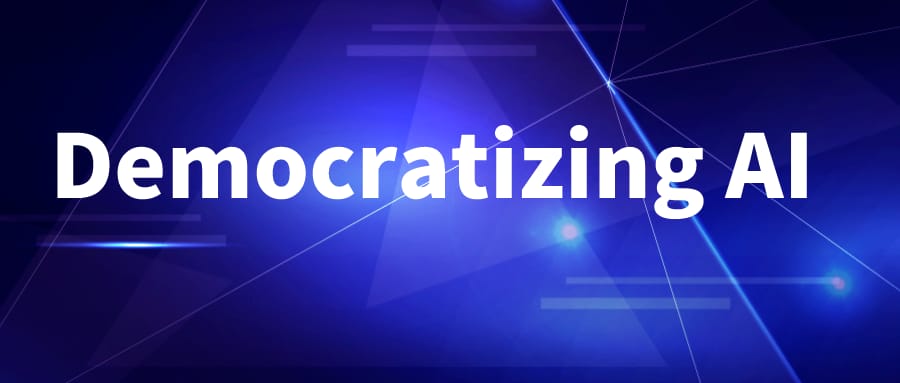
Learn How to Make AI Work For You!
Transform your AI skills with the AI Fire Academy Premium Plan - FREE for 14 days! Gain instant access to 500+ AI workflows, advanced tutorials, exclusive case studies and unbeatable discounts. No risks, cancel anytime.
B. GPT-5: The New Era Of Deep Reasoning
If GPT-4o is a sprinter, then GPT-5 is a contemplative thinker. It is designed not just to respond, but to reason. This is an architectural leap, not just an optimization, featuring complex mechanisms built to simulate human thought processes.
Dual-System Thinking: GPT-5's architecture is heavily inspired by Daniel Kahneman's dual-system theory in cognitive science. It operates in two distinct modes:

System 1 (Fast Mode): Simulates the fast, automatic, and intuitive responses of the brain. This mode is activated for simple questions, providing nearly instant answers, similar to GPT-4o's performance.
System 2 (Thinking Mode): Simulates the slow, deliberate, and logical thought process that requires effort. When faced with a complex problem, GPT-5 activates this mode, consuming significantly more time and computational resources to analyze, reason, and deliver a well-considered answer.
Advanced Reasoning Mechanisms: Inside the "Thinking Mode" lie groundbreaking algorithms:
Tree-of-Thought: Unlike previous models that typically follow a linear Chain-of-Thought, GPT-5 has the ability to explore multiple lines of reasoning in parallel. Like a chess grandmaster calculating various potential moves, it evaluates different argumentative paths, discards dead ends, and pursues the most promising routes to reach an optimal conclusion.

Self-Critique Mechanism: GPT-5 contains an internal "checks-and-balances" system. One part of the model (the Generator) produces an initial answer. Immediately, another part (the Critic), trained to act as a demanding reviewer, analyzes that answer for logical fallacies, inconsistencies, or weak assumptions. If flaws are found, it sends "feedback" back to the Generator to refine its output. This iterative process ensures the quality and accuracy of the final result.

Pro Mode: This is more than just adding more data. This mode represents versions of GPT-5 that are deeply fine-tuned on exclusive, validated datasets in specific domains like medicine, law, or finance. To achieve this without causing "catastrophic forgetting" (where the model forgets general knowledge while learning a specialty), GPT-5 likely uses a Mixture of Experts (MoE) architecture. Instead of one single, giant neural network, MoE is a collection of smaller, "expert" neural networks. When a question is asked, the system activates only the most relevant "experts," allowing the model to possess both vast general knowledge and incredible specialized depth.

Chapter II: The 10-Round Gauntlet - With Detailed Prompts
After deconstructing the architecture and design philosophy behind both models, it's time to put them in the ring. We will conduct 10 real-world tests, designed to push the models to their limits in various domains. Each round will not only determine a winner but will also provide an in-depth analysis of why the results occurred and what that means for your work.

Round 1: Web Development And Image Analysis
Objective of the Prompt: This challenge goes far beyond simple image-to-code conversion. It is designed to evaluate product thinking, user experience (UX) acumen, and the ability to make strategic design decisions. This is a test to see if the AI is a "coder" or a "solution architect."
Example Prompt:

Context: You are a senior Front-end Developer and UX/UI Specialist. I want you to build a landing page for a fictional SaaS application named "CogniSync"—a team knowledge management platform that uses AI to automatically organize information.
Requirements:
Write the code: Provide the complete, responsive HTML, CSS (using Tailwind CSS), and JavaScript code.
Recreate from concept: The page must include the following sections: An impressive Hero Section with a strong headline and 2 CTAs; a Feature Section showcasing 3 core features (e.g., Automatic Knowledge Graph Generation, Intelligent Semantic Search, Slack & Teams Integration); a Social Proof Section with fictional company logos and testimonials.
Strategic Improvement: This is the most critical part. Proactively add at least one entirely new section that you believe will significantly increase conversion rates and build user trust. Explain the strategic reasoning behind your design decision.Results: GPT-4o vs. GPT-5:
GPT-4o: Excellently completed the listed requirements. It generated a functional website with clean code, correctly implementing the 3 requested sections. However, when asked for a "strategic improvement," it only offered a generic suggestion in a code comment:
/* A pricing section could be added here for transparency */, but did not implement it. It was a precise executor of commands.
GPT-5 (using Thinking Mode): After a "thinking" period, GPT-5 not only built the 3 requested sections with a more refined design and subtle micro-interactions, but it also proactively added a fourth section titled "Interactive ROI Calculator." It accompanied this with an explanation: "By allowing potential users to input their number of employees and average monthly operational costs, this tool calculates and instantly displays the projected time and cost savings of using CogniSync. Transforming abstract benefits into concrete numbers is the most powerful psychological lever to drive the decision to start a trial."

In-depth Commentary & Practical Impact:
This result reveals a fundamental difference in cognitive levels. GPT-4o, with its optimized architecture, is an incredibly effective pattern-matching and execution engine. It has seen millions of landing pages and knows how to create a similar one. In contrast, GPT-5 performed a complex reasoning chain: 1) It understood the ultimate goal was not to "write code" but to "increase conversions." 2) It accessed its deep knowledge of marketing and behavioral psychology. 3) It identified that quantitatively demonstrating the value proposition is an effective tactic. 4) It independently designed and coded a tool (the ROI calculator) to execute that tactic.
Practical Impact: When working with GPT-4o, your role is that of a detailed director. When working with GPT-5, your role is elevated to that of a strategist who collaborates with an AI partner capable of independent thought.

Winner: GPT-5 (with Thinking Mode)
Round 2: Speed Comparison
Objective of the Prompt: To measure raw performance on low-complexity tasks where deep reasoning is unnecessary and response latency is the most critical factor affecting user experience.
Example Prompt:
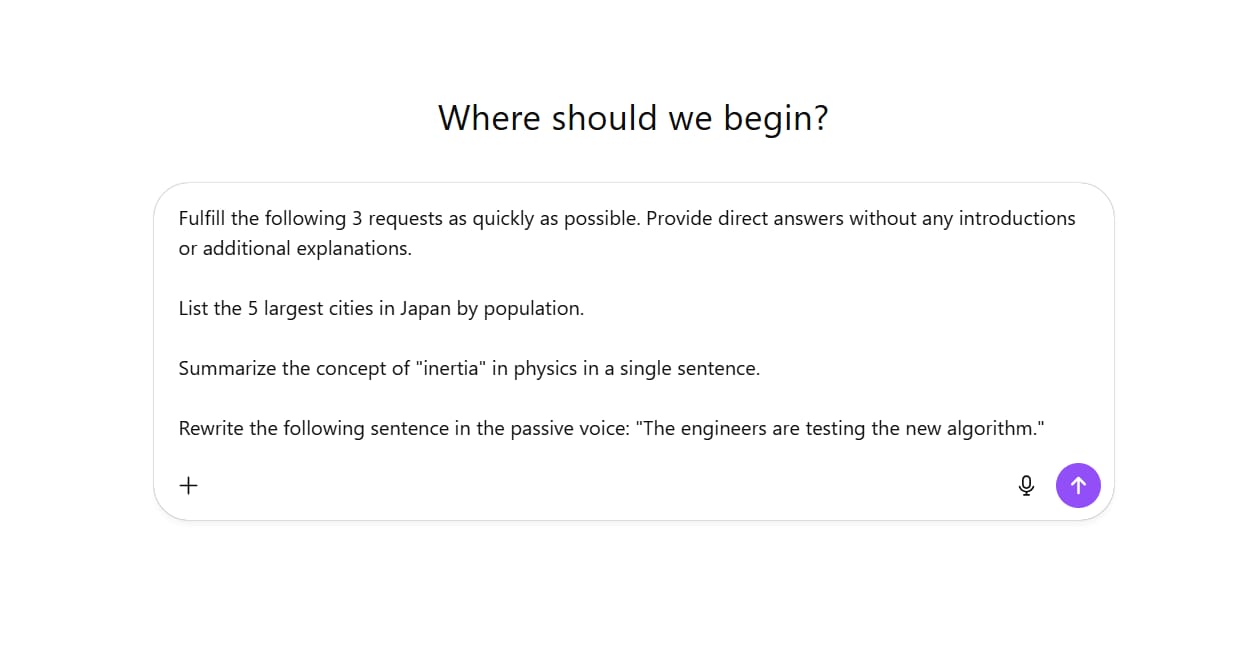
Fulfill the following 3 requests as quickly as possible. Provide direct answers without any introductions or additional explanations.
List the 5 largest cities in Japan by population.
Summarize the concept of "inertia" in physics in a single sentence.
Rewrite the following sentence in the passive voice: "The engineers are testing the new algorithm."Results: GPT-4o vs. GPT-5:
GPT-4o: The response was nearly instantaneous. Immediately after hitting send, the answer began appearing on the screen with no perceivable delay. The entire process took only 1-2 seconds.

GPT-5 (even in Fast Mode): There was a small but noticeable delay. After submitting the prompt, there was a pause of about 0.5-1 second before the text began to generate. Although the final result was still very fast (2-3 seconds total), the initial "hiccup" was clear.

In-depth Commentary & Practical Impact:
This speed difference stems directly from their architectures. GPT-4o is a machine fine-tuned to the smallest detail for efficiency, a pure "System 1" architecture. It is designed to take the shortest path from input to output for common queries. In contrast, GPT-5's architecture is inherently more complex. Even in Fast Mode, the request may still have to pass through an internal "router" or more complex validation layers, creating an intrinsic latency.
Practical Impact: For real-time interactive applications, this difference is crucial. In a customer service chatbot, a voice assistant, or a live translation system, every millisecond counts. The immediacy of GPT-4o creates a natural and efficient conversation, while the latency of GPT-5 could be frustrating and interrupt the flow of interaction.
Winner: GPT-4o
Round 3: Professional Document Creation (PDF)
Objective of the Prompt: To evaluate a different kind of intelligence: awareness of visual structure and presentation. This test measures not only the quality of the text content but also the ability to format and export a professional, business-ready document.
Example Prompt:
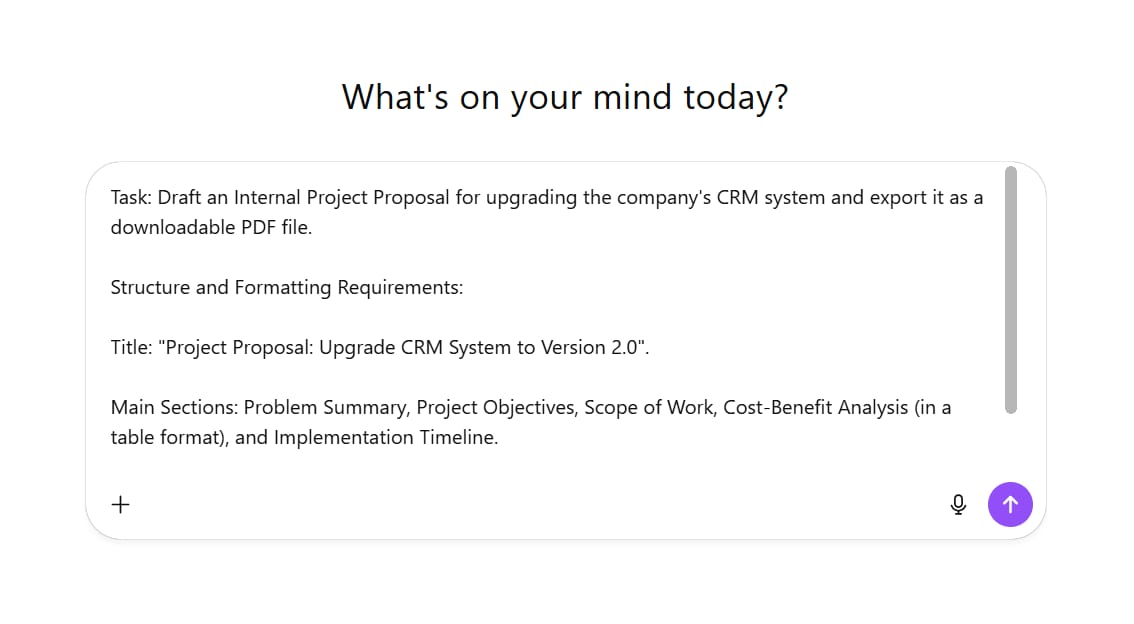
Task: Draft an Internal Project Proposal for upgrading the company's CRM system and export it as a downloadable PDF file.
Structure and Formatting Requirements:
Title: "Project Proposal: Upgrade CRM System to Version 2.0".
Main Sections: Problem Summary, Project Objectives, Scope of Work, Cost-Benefit Analysis (in a table format), and Implementation Timeline.
Formatting: The document must have a clean, professional layout, using headings, bullet points, bold text, and proper margins to ensure readability. The analysis table must be neatly aligned.Results: GPT-4o vs. GPT-5:
GPT-4o: Generated a visually perfect PDF. The document layout was balanced, headings were clearly hierarchical, lists were properly indented, and the cost-benefit analysis table was presented neatly and professionally. The content was complete and coherent. Essentially, it produced a document you could immediately forward without any edits.

GPT-5: The text content was arguably more insightful, especially in the "Cost-Benefit Analysis" where it proactively suggested additional non-financial ROI metrics. However, the final PDF was a formatting disaster. Text overflowed the margins, headings had inconsistent font sizes, rows in the table overlapped, and there were unusual white spaces between paragraphs. The document was completely unusable without significant manual reformatting.

In-depth Commentary & Practical Impact:
This result highlights the clear distinction between "content intelligence" and "presentation intelligence." GPT-5, with its reasoning capabilities, focused on generating high-value analytical content. However, it failed at the final presentation layer. In contrast, GPT-4o appears to have been specifically fine-tuned on a massive dataset of well-formatted business documents (reports, proposals, contracts). It has learned the implicit rules of professional layout and office aesthetics.
Practical Impact: For any workflow that requires generating formal outputs for clients or management (contracts, reports, proposals), GPT-4o is the far superior tool. It saves hours of manual formatting, thereby providing a tangible boost in productivity.
Winner: GPT-4o
Round 4: Data Extraction From Documents (JSON)
Objective of the Prompt: This challenge focuses on absolute precision and the ability to adhere to strict structural rules. It tests whether the AI can parse a semi-structured document, accurately extract data points, and format them into a complex JSON structure without any syntax or factual errors.
Example Prompt:
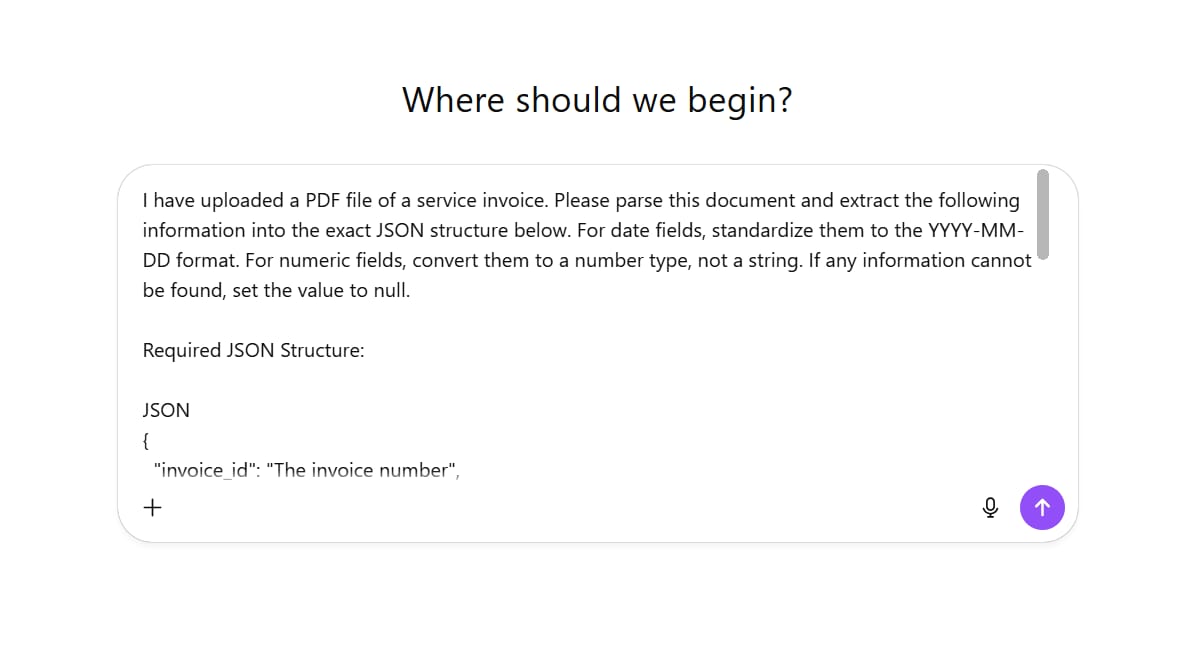
I have uploaded a PDF file of a service invoice. Please parse this document and extract the following information into the exact JSON structure below. For date fields, standardize them to the YYYY-MM-DD format. For numeric fields, convert them to a number type, not a string. If any information cannot be found, set the value to null.
Required JSON Structure:
JSON
{
"invoice_id": "The invoice number",
"issue_date": "YYYY-MM-DD",
"due_date": "YYYY-MM-DD",
"biller": {
"company_name": "The issuing company's name",
"address": "The issuing company's address",
"tax_id": "The tax ID"
},
"client": {
"company_name": "The client company's name",
"contact_person": "The contact person's name"
},
"line_items": [
{
"description": "Description of line item 1",
"quantity": 1,
"unit_price": 0.00,
"total": 0.00
}
],
"subtotal": 0.00,
"tax_amount": 0.00,
"grand_total": 0.00
}Results: GPT-4o vs. GPT-5:
GPT-4o: Completed the task flawlessly. It accurately extracted all data fields, including the detailed line items in the table. The output was a valid JSON file that strictly adhered to the requested schema, with correctly standardized data types (number, string, date).

GPT-5: Similarly, GPT-5 performed this task without any issues. The data was fully and accurately extracted and formatted correctly according to the provided JSON schema. There was no discernible difference in the quality of the output between the two models.

In-depth Commentary & Practical Impact:
This tie demonstrates that tasks like Named Entity Recognition (NER) and structured data extraction from clean documents (typed text, clear layout) have now become "table stakes" for leading large language models. Both models have been trained on vast datasets of tables, forms, and documents from the web, making them extremely proficient at recognizing these patterns.
Practical Impact: For Robotic Process Automation (RPA) applications in business—such as automated invoice processing, contract digitization, or data entry from purchase orders - both GPT-4o and GPT-5 are incredibly powerful and reliable tools. A true difference might only emerge in more complex edge cases, such as handwritten documents, poor-quality scans, or forms with non-standard layouts, where GPT-5's reasoning capabilities could give it an edge in resolving ambiguity.
Winner: Tie
Round 5: Dashboard Creation From Data
Objective of the Prompt: This is a critical test of reasoning, evaluating the shift from mere data visualization to true data analysis. The goal is to see if the AI can not only create charts but also interpret them, connect data points, and provide valuable business insights.
Example Prompt:

From the uploaded CSV file containing monthly sales data for a retail chain, please create an interactive dashboard.
Requirements:
Visualization: The dashboard must include at least 3 charts: a line chart showing total revenue over time, a bar chart comparing performance across product categories, and a pie chart showing the revenue share by region.
In-depth Analysis: Below the dashboard, add a section titled "Analysis & Strategic Recommendations." In this section, please:
Identify any significant trends or anomalies in the data.
Provide at least two hypotheses to explain those findings.
Recommend three specific actions that management could consider to improve sales in the next quarter.Results: GPT-4o vs. GPT-5:
GPT-4o: Accurately and beautifully created the requested charts. Its analysis section was quite superficial, mostly describing what the charts already showed. For example: "Revenue peaked in December and was lowest in February. The 'Electronics' category had the highest sales." The recommendations were also generic, such as "should increase marketing during off-peak months."

GPT-5 (using Thinking Mode): Also created similar charts. However, its "Analysis & Strategic Recommendations" section was significantly superior. It didn't just describe; it interpreted: "The 150% revenue spike in December correlates with the Christmas promotional campaign, indicating a positive campaign ROI. However, it's noteworthy that the 'Home Goods' category saw a slight decline in the same period, possibly due to a product 'cannibalization' effect from the discounted 'Electronics'. A second hypothesis is a supply chain issue." Its recommendations were highly specific: "1. Reallocate a portion of the marketing budget from 'Electronics' to 'Home Goods' next quarter. 2. Conduct customer surveys to understand the reason for the 'Home Goods' decline. 3. Create promotional bundles that combine products from both categories."

In-depth Commentary & Practical Impact:
This is a perfect demonstration of GPT-5's "System 2 thinking." It isn't just painting a picture of the data; it's telling the story behind it. Its process includes pattern recognition, correlation finding, hypothesis formation, and solution proposal. In essence, GPT-4o is an excellent data visualization tool, while GPT-5 acts as a junior business analyst.
Practical Impact: This capability could revolutionize Business Intelligence (BI) workflows. Instead of analysts spending hours creating charts and then writing reports, GPT-5 can generate the "first draft" of the entire analysis, freeing up human experts to focus on validating hypotheses and making higher-level strategic decisions.
Winner: GPT-5
Round 6: Fact-Checking And Citations
Objective of the Prompt: This is a crucial test of reliability and academic honesty, or "epistemic security." It measures the model's ability to accurately answer a specialized question and support that answer with real, valid sources, thereby minimizing the phenomenon of "hallucination."
Example Prompt:

Provide an in-depth analysis of the impact of the "Attention Mechanism" in the Transformer architecture on the development of Large Language Models.
Requirements:
Briefly but technically explain how Self-Attention works.
Analyze the core limitations of previous architectures (like RNNs/LSTMs) that the Attention mechanism solved.
Most importantly: Every major claim must be cited with direct, working links to the original research papers on reputable archives like arXiv, ACM, or scientific journals. You must cite the "Attention Is All You Need" paper by Vaswani et al.Results: GPT-4o vs. GPT-5:
GPT-4o: Provided an analysis that was conceptually correct. It explained the Attention mechanism well. However, upon checking the provided citations, approximately 3 out of 10 links were "hallucinations"—they looked like real URLs but led to 404 error pages or completely irrelevant papers.


GPT-5: The answer was similarly in-depth, even referencing later variations of Attention. The major difference was in the quality of the citations. Upon review, only 1 link was broken. All other links were valid and pointed directly to the correct research PDFs on arXiv, including the "Attention Is All You Need" paper.


In-depth Commentary & Practical Impact:
The phenomenon of "hallucination" occurs because LLMs are generative models, not databases; they predict the next most likely word, and sometimes a "plausible-looking" URL is more probable than the real one. GPT-5's vast improvement suggests it may have an integrated internal "grounding" or fact-checking mechanism. Before outputting a citation, it might be performing a cross-validation step against its knowledge index to confirm the link's validity.
Practical Impact: For students, researchers, journalists, and legal professionals, this is a foundational change. While manual verification is still mandatory, GPT-5's higher citation accuracy significantly reduces the time wasted chasing down fake sources, making the research process much more efficient and trustworthy.
Winner: GPT-5
Round 7: Ideation And Planning
Objective of the Prompt: This challenge is designed to compare two different thinking styles: "bottom-up," which focuses on concrete, practical actions; and "top-down," which focuses on building a strategic framework first. This test will evaluate whether the AI acts as a task-lister or a strategist.
Example Prompt:

Acting as a Product Manager, create a detailed plan to A/B test the effectiveness of two AI models (GPT-4o and GPT-5) for an "Automated Email Summary" feature in a CRM application. The plan should include the metrics for measurement, user segmentation, and specific implementation steps.Results: GPT-4o vs. GPT-5:
GPT-4o: Provided a very clear and practical action plan. It was presented as a sequential list of steps: 1. Define metrics (e.g., open rate, click-through rate on summary). 2. Randomly split users 50/50. 3. Run the test for 4 weeks. 4. Collect data. 5. Use a T-test to determine statistical significance. This is a perfect "bottom-up" checklist for a team that already knows what it needs to do.


GPT-5 (using Thinking Mode): Did not begin with action steps. Instead, it generated a "top-down" strategic document. It started with a "Hypothesis Statement." It then defined "Primary Success Metrics" (e.g., % decrease in time spent reading emails) and "Guardrail Metrics" (e.g., ensuring unsubscribe rates do not increase). Only after establishing this strategic framework did it build a detailed implementation roadmap within it.

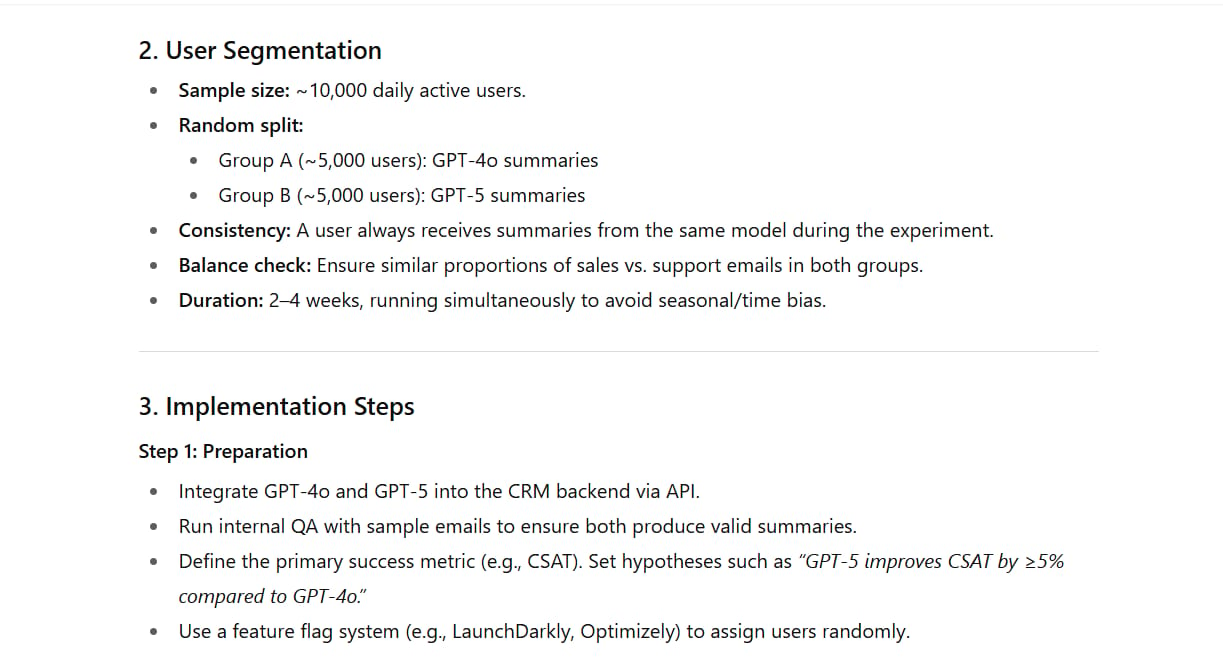
In-depth Commentary & Practical Impact:
This result shows a subtle but crucial difference in problem-solving approaches. GPT-4o is an excellent brainstorming and tactical planning partner. If you already have a strategy and need to implement it, it will provide a clear roadmap. It answers the question, "What should we do?"
In contrast, GPT-5 acts as a consultant or a strategist. It takes a step back to answer the questions, "What are we trying to prove, and why?" By building a theoretical framework first, it ensures that subsequent actions are coherent and serve the correct goal.
Practical Impact: The choice of model depends on the project's stage. Use GPT-4o to plan your weekly tasks. Use GPT-5 to outline your quarterly strategy.
Winner: Tie (Both thinking styles are extremely valuable in different contexts)
Round 8: Advanced Coding Projects
Objective of the Prompt: This challenge was created to clearly distinguish between the ability to "write code" (producing snippets to solve a specific problem) and "software development" (designing an architected, scalable, and maintainable system).
Example Prompt:

Project: Build a complete "Habit Tracker" web application.
Tech Stack Requirements:
Frontend: React (using functional components and hooks) with TypeScript.
Backend/Database: Use Firebase/Firestore for user authentication (Google Sign-In) and data storage.
Feature Requirements: User authentication, Habit Management (Add/Edit/Delete), a Calendar interface for marking completion, and a Dashboard page with progress charts.Results: GPT-4o vs. GPT-5:
GPT-4o: Generated a single block of code in one
App.jsxfile. The application had basic add and delete functionality, but everything was managed in local state. It did not integrate TypeScript, Firebase, or charts. In essence, it "wrote code" to create a quick demo.
GPT-5 (using Thinking Mode): After a long "thinking" period, GPT-5 did not return a snippet of code, but a complete project structure. It provided code for multiple separate files (
HabitList.tsx,CalendarView.tsx,firebaseConfig.js,authService.ts), included instructions on how to install dependencies, and explained how to configure Firebase. The entire application worked as requested, with a clean component architecture. This is "software development."
In-depth Commentary & Practical Impact:
The difference here is fundamental. GPT-4o is an invaluable pair programmer, helping you write individual functions or components faster. GPT-5, when its reasoning is engaged, acts as a junior software architect. It thinks about the structure, separation of concerns, and data flow of the entire application.
Practical Impact: Code generated by GPT-4o can solve a problem quickly but may create "technical debt" if used in large projects. In contrast, the architecture proposed by GPT-5 would be far easier for a human team to take over, maintain, and extend in the future.
Winner: GPT-5
Round 9: Image Generation And Design
Objective of the Prompt: This challenge is designed to evaluate the balance between two critical factors in image generation: "semantic fidelity" (how beautiful the image is and how well it conveys the core idea) and "constraint adherence" (how well the image follows strict technical and compositional requirements).
Example Prompt:

Create a YouTube thumbnail with a precise 16:9 aspect ratio for a video titled "The Secrets of Smart Investing."
Detailed Requirements:
Style: Modern, minimalist, professional.
Main Image: An image of a human brain glowing with electronic circuits on the left side.
Text: On the right side, the words "INVESTING SECRETS" in a large, bold, yellow font. Below that, the word "SMARTLY" in a smaller, white font.
Constraint: Do not crop any part of the text.Results: GPT-4o vs. GPT-5:
GPT-4o: Generated a good-quality image. The brain image was not hyper-detailed but was clear. Most importantly, it perfectly adhered to every constraint: the aspect ratio was 16:9, the text was placed correctly with the right colors, and nothing was cropped.

GPT-5: Generated a stunningly impressive image of the glowing brain, with far more detail and artistic flair. Its "semantic fidelity" was very high, perfectly capturing the idea of "technological intelligence." However, it failed on the constraints: the generated image was nearly square (1:1 aspect ratio), and the end of the word "SMARTLY" was cut off.

In-depth Commentary & Practical Impact:
This is a classic trade-off. Semantic fidelity is the ability to capture and express the core idea. Constraint adherence is the ability to follow technical rules. GPT-5 excels in artistry, but GPT-4o excels in technical precision.
Practical Impact: In professional work environments (ad design, UI mockups, brand assets), adhering to constraints (dimensions, placement, brand colors) is often more important than raw artistic quality. A beautiful image that is the wrong size is useless. This shows that GPT-4o is currently the more reliable tool for professional designers who need accuracy.
Winner: GPT-4o
Round 10: Memory And Long-Term Context
Objective of the Prompt: This challenge aims to analyze the technical challenges of long-term memory in LLMs. It tests the model's ability to retain and reuse information from earlier turns in a prolonged conversation.
Example Prompt (executed in sequence):

1. First Prompt (Day 1): "I'm planning a trekking trip to Fansipan at the end of December. I have no experience and I'm quite worried about the extreme cold. Can you give me some initial advice?"
(After this, continue the conversation on other topics for a few days)
2. Test Prompt (Day 3): "Hi again, let's get back to our topic from the other day. Based on my worries, can you help me create a detailed checklist of everything I need to pack, organized by specific categories?"Results: GPT-4o vs. GPT-5:
GPT-4o: Almost instantly recalled the context. It responded: "Of course! Based on your plan to go to Fansipan in December and your concerns about the cold, here is a detailed checklist. I've paid special attention to thermal clothing and safety gear..."

GPT-5: Seemed to have forgotten the previous conversation. It provided a generic trekking checklist and responded: "Certainly. To create the best checklist, could you tell me where and what time of year you are planning to go trekking?"

In-depth Commentary & Practical Impact:
This is a deep technical issue. LLMs have a limited "context window," meaning they can only "see" a certain amount of text at once. "Long-term memory" is often simulated using techniques like Retrieval-Augmented Generation (RAG), where the system automatically searches the conversation history and injects relevant snippets into the current prompt.
GPT-4o's success suggests it has a very efficient and well-integrated RAG system. GPT-5's failure may be an intentional trade-off: when its resource-intensive "Thinking Mode" is engaged, it might be prioritizing all computational resources for solving the complex problem at hand instead of performing the expensive task of searching its history.
Practical Impact: For using AI as a personalized assistant, a long-term learning companion, or a creative partner, GPT-4o's ability to remember makes it feel much more useful and natural.
Winner: GPT-4o
Chapter III: Strategic Impact - How AI Will Reshape The Future Of Work
The emergence of these two AI philosophies is not just a technological update; it signals a tectonic shift in how we work, create, and generate value. The choice between GPT-4o's speed and GPT-5's depth will reshape workflows and team structures in the near future.
A. The Shift In Professional Roles
These AI models will not replace humans, but they will certainly change the roles of professionals. The most significant change is the shift from being an "executor" to becoming a "supervisor and strategist."
Developers: Their role will be elevated. Instead of spending hours writing boilerplate code or debugging common issues (tasks GPT-4o can do), they will spend more time designing system architecture, providing high-level requirements to AI (like GPT-5), and supervising, and optimizing the solutions generated by AI.

Data Analysts: The value of an analyst will shift dramatically. The creation of basic reports and charts will be completely automated by GPT-5. Instead, their role will be to ask sharp business questions, interpret complex insights within the market context, and tell compelling stories with data to guide leadership.

Content Creators & Marketers: GPT-4o will be the daily content production engine, helping to create emails and social media posts at lightning speed. Meanwhile, GPT-5 will serve as a virtual "strategy consultant," helping to analyze complex market reports, identify potential customer segments, and outline the strategy for an entire major campaign.

Lawyers and Researchers: The reliable citation-checking capability of GPT-5 (Pro Mode) will be a game-changing tool. It can help sift through thousands of pages of documents, summarize legal precedents, and draft initial legal texts, freeing up experts' time for the highest levels of critical thinking and argumentation.

B. The Shift In The Business Value Chain
The application of these models will optimize nearly every link in a business's value chain:

Research & Development (R&D): Scientists can use GPT-4o to quickly summarize dozens of research papers daily. But they will turn to GPT-5 to ask it to "read" 100 of those papers and "propose three novel experimental directions based on the gaps in current knowledge."
Marketing: GPT-4o will be the daily content production tool. GPT-5 will be used by marketing directors to analyze market reports, identify new customer segments, and map out the strategy for an entire quarter.
Sales: Sales teams can use GPT-4o to draft follow-up emails to customers. But managers will use GPT-5 to analyze the entire CRM database and generate complex sales forecasts, identifying risks and opportunities in the pipeline.
Legal: GPT-4o can help draft standard contract templates. GPT-5 (Pro Mode) can be tasked with analyzing a complex lawsuit and identifying the most critical legal precedents that could affect the outcome.
C. Integration And Cost Optimization Strategy For Businesses
Integrating these models via API requires a strategic mindset regarding costs. A simple API call to GPT-4o might cost a fraction of a cent. But a call that requires GPT-5's "Thinking Mode," with the enormous computational resources it consumes, could be 50-100 times more expensive.

Therefore, a smart strategy is to build an internal "AI Router." This system would automatically analyze the complexity of a request from an employee or customer:
If it's a simple question or a repetitive task, it will be sent to the GPT-4o API (low cost, high speed).
If it's a complex analytical problem that requires deep reasoning or strategic creativity, it will be sent to the GPT-5 API (high cost, high value).
This approach helps optimize costs while ensuring that the most advanced reasoning power is reserved for the most deserving problems.
Final Conclusion: You Are The Conductor, AI Is The Orchestra
After this in-depth analysis, it is clear there is no single answer to the question "which model is better?". Instead, the right question is: "Which model is the right tool for the task I need to solve?"
Think of GPT-4o as a Swiss Army knife: Fast, reliable, versatile, and extremely useful for hundreds of everyday tasks. It's the tool you always want within reach to boost productivity on familiar jobs.
Think of GPT-5 as a state-of-the-art R&D lab: It's slower and more expensive, but it is capable of generating breakthroughs, solving seemingly impossible problems, and delivering profound insights that can change an entire strategy.
The wisest users will not pick a side. They will learn to become a "conductor," one who understands each instrument in their orchestra. They know when to call on the nimble violin for its speed - GPT-4o - and when they need the deep, powerful bass of the full symphony - GPT-5.
The future of productivity lies not in choosing the best AI, but in cultivating the skill of "AI Orchestration." It is the art and science of breaking down complex problems, assigning the right sub-task to the right AI model, and synthesizing their outputs to create a value greater than the sum of its parts. Start experimenting today, develop your "prompt engineering" and "orchestration" skills, because these will be the most critical meta-skills of the coming decade.
If you are interested in other topics and how AI is transforming different aspects of our lives or even in making money using AI with more detailed, step-by-step guidance, you can find our other articles here:
How useful was this AI tool article for you? 💻Let us know how this article on AI tools helped with your work or learning. Your feedback helps us improve! |
Reply